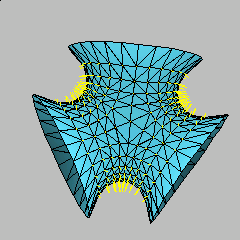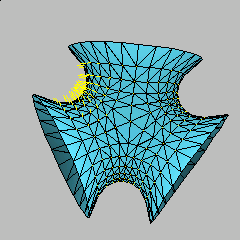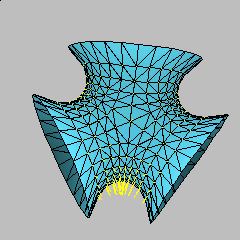

 |
 |
 |
An unstable minimal trinoid with three discrete eigenvector fields of the Jacobi operator.
Sufficiently large pieces of smooth minimal trinoids are unstable with respect to area and have index 3, i.e. the associated Jacobi operator has three negative eigenvalues. For a discrete minimal trinoid we confirm this result experimentally and compute the three negative eigenvalues of its discrete Jacobi operator [1][4]. The eigenvector fields associated to these negative eigenvalues are shown in the models as variation vector fields on the interior vertices of the surface. Moving all vertices in the direction of any of these fields reduces area to second order.
We define discrete compact minimal surfaces as piecewise linear continuous compact triangulated surfaces that are critical for the area functional with respect to all variations through surfaces of the same type that preserve the simplicial structure and the boundary. See the model "Discrete minimal surfaces do not have a maximum principle" [5] in this model server for a more thorough definition.
Although discrete minimal surfaces are critical for area, they are not necessarily area minimizing. The discrete trinoid shown here is a numerically computed unstable critical point of the discrete area functional.
Associated to the discrete area functional is a linear operator, the discrete Jacobi operator [1]. As the surface is unstable, the operator has negative eigenvalues, in fact, there are three negative eigenvalues. The corresponding first three eigenvector fields are shown here as vector fields. The base geometry is the same in all three models.
The first eigenfield shown here has the lowest associated eigenvalue. The other two eigenfields are tied, in the sense that they have the same associated eigenvalue. Hence the second eigenvalue has a two dimensional eigenspace spanned by these last two eigenfields. (We have chosen the second eigenfield and a 120 degree rotated copy of it as a basis for the eigenspace.)
As the first eigenfield shown here lies in a 1 dimensional eigenspace, it must maintain the 3-fold symmetry of the surface. It also maintains the same sign across the whole surface, as we would expect from the eigenfield associated to the first eigenvalue. However, the latter two eigenfields need not (and in fact do not) maintain the 3-fold symmetry. Furthermore, they do not keep the same sign across the whole surface, as we would expect from eigenfields associated to the second and higher eigenvalues.
Model produced with: JavaView version 2.04.001
| Keywords | Minimal Surface; Discrete Surface; Trinoid; Jacobi Operator | |
| MSC-2000 Classification | 53-04 (53-XX, 68Uxx, 68Rxx, 65Kxx, 65M50) | |
| Zentralblatt No. | 01683032 |
Submitted: Mon Jan 22 09:21:14 CET 2001.
Revised: Mon Aug 27 19:01:34 CET 2001, Tue Aug 28 09:59:32 CET 2001.
Accepted: Tue Sep 11 15:17:04 CET 2001.
Technische Universität BerlinWayne Rossman
Fachbereich Mathematik
Straße des 17. Juni 136
10623 Berlin
Germany
polthier@math.tu-berlin.de
http://www-sfb288.math.tu-berlin.de/~konrad
Kobe University
Mathematics Department
Faculty of Science
Rokko, Kobe 657-8501
Japan
wayne@math.kobe-u.ac.jp
http://www.math.kobe-u.ac.jp/HOME/wayne/wayne.html